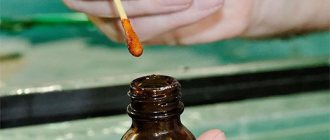Papillomas are benign growths on human skin caused by the human papillomavirus. They do not always pose a threat to human health, but nevertheless such neoplasms do not look aesthetically pleasing.
Iodine for papillomas is a well-known folk remedy. There are many opinions for and against using iodine to remove warts. So, from this article you will find out whether it is possible to cauterize papillomas with iodine.
What are papillomas
A wart, scientifically called a papilloma , does not appear on the body just like that. In ancient times, the cause of the appearance of papillomas was considered to be the evil eye, frogs, and much more. But only now, with the advent of modern molecular diagnostic methods, has it become clear: the cause of papillomas is the human papillomavirus (HPV).
Today, more than 100 types of HPV are known. It is reliably known that HPV type 2 primarily affects the skin, causing the appearance of warts, and HPV 6, 11, 16, 18, 30, 31, 33 , etc. gravitate to the mucous membranes.
The human papillomavirus has long been considered the cause of only skin and genital warts, and only relatively recently have the oncogenic properties of papillomaviruses been discovered - their ability to cause cancer and, first of all, cancer of the genital organs in both men and women.
Based on long-term research, doctors have created a classification of HPV according to its oncogenic activity:
“High-risk” HPV types ( most notably 16, 18, 31 and 45 ). Increase the risk of precancerous diseases and genital cancer. “Low risk” HPV types (mainly 6 and 11). They cause the appearance of condylomas, but are not associated with precancerous diseases and cancer of the genital organs.
The presence of “high-risk” HPV in the body increases the likelihood of developing cancer by 60 times.
How does the virus manifest itself?
An important circumstance is that clinical manifestations of HPV are not detected for quite a long time. Focusing on a long asymptomatic period, one should not underestimate the danger of human papillomavirus infection.
Already today in the United States, infection caused by HPV is the most common viral disease, predominantly sexually transmitted (in our country, large-scale studies in this direction have not yet been conducted).
Plus, HPV damage to the cervix, even in the presence of clinical manifestations, often goes undetected for a long time.
Infection with the human papillomavirus usually occurs through close contact with the source of infection. HPV can be transmitted with scales peeled off with papillomas during sexual play with hands, during sexual intercourse, and when women use hygienic tampons, it can be carried from the external genitalia into the vagina, onto the cervix. Infection of newborns during childbirth is possible.
Each wart, papilloma or condyloma (these are just different names for the same disease, differing only in the place of manifestation of the tumors) is a reservoir for the human papillomavirus.
This virus also accumulates in the tissues surrounding the tumor, which can cause changes in the DNA of epithelial cells of the skin or mucous membranes of the genital organs, resulting in the development of precancerous conditions.
Papillomas manifest themselves as papillary growths protruding above the surface of the skin or mucous membrane, most often have a thin stalk, and sometimes a wide base.
They can take on bizarre shapes that look like hairs, cauliflower or a cockscomb.
Types of papillomas
Depending on the location, the following types of external manifestations of HPV are distinguished:
- Vulgar (simple) warts , which account for up to 70% of all skin warts and are more common in school-age children. They are elevations above the surface of the skin with an uneven, keratinized surface. They most often appear on the hands, but can be on the edges of the lips, on the face and, extremely rarely, on the oral mucosa.
- Flat (juvenile) warts are less common (4%). They are found in children and young people on the back of the hands and feet, face, and oral mucosa. These are warts of different shapes; they have a smooth surface and slightly rise above the skin level.
- Palmoplantar warts are very common (34% of cutaneous warts). They are dense formations with horny layers.
- Filiform warts are soft, flesh-colored to dark brown papillomas, often pedunculated. They are located on the neck, skin of the eyelids, armpits, groin, under the mammary glands.
- Genital condylomas are multiple, less often single, soft papillomas located on the mucous membranes of the genital organs, around and inside the rectum, sometimes in the urethra. They have the appearance of simple (pyramid, ball) or complex (cauliflower) growths with a keratinizing surface on the stalk.
Removal of papillomas
The question of the need to remove papillomas is decided unequivocally - it must be removed. It is not without reason that, literally translated from some languages, a wart means “extra meat.”
In addition, damage to papillomas, when they reach large sizes or are injured by linen and clothing, leads to the formation of long-healing, easily bleeding wounds into which infection can penetrate.
Removal can be done using various methods: traditional surgery, chemical cauterization, thermal or cryodestruction.
The most modern and safe types of surgery are radio wave and laser. The impact on surrounding healthy tissue is minimized.
When removing warts and papillomas using these methods, the formation of scars or scars in their place is almost completely eliminated. Healing of the skin after removal occurs within several days. In parallel with the removal, antiviral therapy is necessarily carried out.
Useful properties of iodine
Iodine has many beneficial properties; it is recommended to cauterize condylomas and treat wounds to avoid infection
Iodine has many beneficial properties; they are recommended to cauterize condylomas, treat wounds to avoid infection, treat fungal-affected areas of the skin, and gargle during inflammatory processes.
There is such an expression as “iodine network”. External use of the drug causes reflex responses from internal organs.
This is explained by the dilation of blood vessels in the skin under the influence of iodine and the outflow of blood, which entails a contraction of tissues in which inflammation progresses.
Draw a mesh on the chest and back of a patient with bronchitis, pleurisy, pneumonia. This method is used for pain in muscles, lower back, and joints.
Iodine solution is taken orally in very small doses. This is done in case of severe coughing attacks, atherosclerosis, inflammation of the respiratory tract, and mercury poisoning.
A few drops of the drug are dripped into a mug of warm water and drunk. This is done for problems with the thyroid gland and during the tertiary period of syphilis.
Many medications containing iodine are aimed at treating sore throats, laryngitis, pharyngitis, and other inflammatory diseases of the larynx.
It would be wrong if we forget about the properties of iodine when removing benign skin tumors such as condylomas, papillomas, and warts.
What iodine-containing drugs can be used for papillomas?
Papillomas can be removed not only with iodine in its pure form, but also with medications based on this substance. Various iodine-containing tinctures, solutions, ointments and even patches are effective in the fight against neoplasms, the main types of which are presented in the table:
| Name | Description |
| "Iodinol" | A slightly toxic pharmaceutical product that has antiseptic and bactericidal properties. |
| Lugol's solution | A medication based on molecular iodine is used for infectious and inflammatory diseases. The solution is popular for its antiseptic, methane-irritating and antifungal properties. |
| "Povidone-iodine" | Disinfectant, antiseptic drug with a wide spectrum of antimicrobial action. Available in the form of a suppository, it has a longer lasting effect than an iodine solution. |
| "Iodonate" | An iodine-based medicine with a pronounced bactericidal effect. Before use, the drug is diluted with purified water. |
| Iodine tincture | An effective antiseptic with which you can quickly get rid of pathogenic microorganisms that pose a danger to the affected area of the epidermis. It is worth remembering that the use of iodine tincture should be dosed, since excessive use of this substance can lead to skin irritation. |
Is it possible to cauterize papillomas and condylomas?
Papillomas are often localized on the neck, chest, armpits, face, and arms above the elbow. All these parts of the body are considered open, and such neoplasms worsen the aesthetic appearance. Many people try to get rid of such “decorations”.
Condylomas appear on the genitals of men and women.
They often affect areas around the anus, and do not disdain the internal walls of the anus, vagina, and cervix. And, as a rule, the first thing people are interested in is the issue of treating formations in inexpensive and accessible ways at home.
Iodine is often used to cauterize warts, but is it possible to get rid of condylomas on the body this way and is it safe?
An iodine solution promotes the coagulation of protein tissue in pathological growths on the skin and mucous membrane. This drug has found wide use in the fight against such problems and has already helped a considerable number of patients with condylomatosis.
Only when using iodine, you must be extremely careful when applying. The solution can cause a burn on healthy tissue around the tumor.
The skin, especially the mucous membrane, is very susceptible to the drying effect of iodine. At the site of the burn, pain, severe burning sensations, and later the convergence of the upper layer of the epidermis are noted.
Even after complete healing, such a process can leave a mark on the body in the form of a small scar or pigment spot.
When using this product, you should be extremely careful and apply it exclusively to the growth. Try not to touch healthy tissue next to papillomas or condylomas.
Traditional methods of getting rid of papillomas
Medicine did not appear today, but our ancestors have always treated diseases. To get rid of papillomas, the following traditional methods of treatment have been offered for many years:
- juices of celandine and Kalanchoe;
- laundry and tar soap;
- castor and tea tree oils;
- soda and ammonia;
- garlic and green walnut peel;
- iodine and brilliant green.
All of them are good to one degree or another, they help get rid of an unsightly cosmetic defect or leave it unchanged. We are interested in self-medication of papillomas with iodine - is it possible, and whether it is necessary to do it.
Rice. 2. Cauterization of papillomas with iodine should be carried out pointwise, preventing the drug from spreading.
Stages of iodine treatment
The effect of treatment for genital warts will depend on factors:
- Number of neoplasms.
- Size of growths.
- Locations.
- Intensity of drug application.
- Cauterization frequencies.
It is necessary to smear the formations with a cauterizing solution 3-5 times a day, without missing a single day, until the growths disappear
Treatment of condylomas with iodine is allowed for small single formations. Multiple large growths are best removed using traditional medicine.
The method of treating genital warts can be compared with chemical coagulation, only this remedy is characterized by greater safety in comparison with the acids that are part of chemical reagents.
In order to remove condylomas with iodine, you need to be patient and be careful when applying the drug, as well as:
- Before the procedure, you need to make sure that the treatment area is clean and dry;
- It is advisable, in order to avoid burns, to treat the skin around the pathological area with cream, without touching the growth itself;
- smear the formations with a cauterizing solution 3-5 times a day, without missing a single day, until the growths fall off.
The result will take 7-10 days, provided that all stages of treatment are followed.
Iodine and papillomas
Strictly speaking, iodine is a chemical element, a halogen, under normal conditions it is in a solid crystalline state. The usual bottle from the pharmacy is the substance iodine dissolved in ethanol. Its spectrum of action is wide, it simultaneously has antiseptic, anti-inflammatory, antimicrobial, hypolipidemic, and local irritant properties. Its undeniable advantages include:
- inexpensive cost;
- constant availability in pharmacies;
- moderately gentle effect on the skin;
- good tolerance by the body;
- a small number of contraindications.
Rice. 3. Consult your doctor if self-treatment of papillomas has not been effective.
Contraindications for use
Cauterizing condylomas is not a harmless method of combating the growth of pathological cells. The product has contraindications:
People with particularly sensitive skin may experience an allergic reaction. It manifests itself:
- swelling of tissues;
- redness of the skin around the treatment site;
- local temperature rise;
- severe burns;
- sometimes itching, pain;
- swelling of the mucous membrane (you need to be especially careful when rinsing the larynx and using Lugol's solution to treat inflammation of the throat);
- weeping and even the appearance of blisters.
Patients who have problems with the thyroid gland, in particular its hyperfunction, are prohibited from smearing condylomas with iodine.
Those suffering from a disease such as Dühring's dermatitis are also not recommended to resort to this method of treating skin tumors.
Those who have pathological changes on the skin due to diabetes should refrain from using iodine solution on genital warts.
It is not worth cauterizing condylomas of different sizes with iodine if their location is the mucous membranes.
Sometimes the opposite effect occurs from using this remedy. Some patients complain: “I apply it, but new tumors appear.” This fact should not be overlooked and the course of therapy should be monitored.
To record changes in a positive trend or a negative effect of the drug, it is recommended to photograph the problem area during treatment to assess its condition.
IMPORTANT! Cauterization should be stopped if any adverse symptoms, changes in adjacent tissues or in the general condition of the patient are noticed.
Do not forget that the causative agent of all types of condylomas is the human papillomavirus. To effectively combat this disease, it is necessary to treat external manifestations on the skin and mucous membranes, and reduce the amount of virus in the body.
The human immune system must fight this pathogen. And in people with reduced, weak immunity, the effects of the virus are manifested by all sorts of growths on the skin.
In addition to cauterizing tumors, it is worth using antiviral drugs and immunostimulants. Otherwise, neither iodine nor other removal methods will be able to get rid of such troubles for a long time.
By the way, those who do not have a weak body’s ability to resist may never know that they were infected with HPV.
Details of treatment of papillomas with iodine
In order to cauterize papillomas with iodine most effectively, remember some rules and recommendations:
- the shape of the papilloma does not matter, but its size is important - only small papillomas can be cauterized;
- be sure to make sure that you do not have an allergic reaction to iodine;
- before starting cauterization, the surface of the skin must be degreased (it is enough to wash the area with soap), and the skin adjacent to the papilloma should be smeared with greasy cream or Vaseline;
- Apply iodine pointwise to the surface of the papilloma, avoid pressing and avoiding contact with the skin around it;
- Only whole intact papillomas can be processed;
- prolonged exposure to iodine in the form of compresses is unacceptable;
- The treatment regimen is as follows: apply iodine to the papilloma 2-3 times a day daily; If the method suits you, the papilloma will dry out and disappear within 2 weeks.
Before starting self-medication, even if it concerns something as trivial at first glance as manipulating iodine, do not be too lazy to consult a doctor. This will at least save you from vain hopes, and at maximum prevent the development of serious complications. Take care of your health!
How to care for the wound after papilloma removal
The wound after removal of the papilloma is a funnel-shaped depression, which corresponds in diameter and depth to the eliminated skin formation.
The wound after removal of the papilloma is a funnel-shaped depression, which corresponds in diameter and depth to the eliminated skin formation.
Swelling and redness of the surrounding skin is likely for 24 hours after surgery. For the formation of a scab, constant ventilation of the wound is necessary.
Fresh air dries the lymphatic fluid protruding to the surface, which coagulates and forms first a film and then a crust. Under this crust, epithelization of the wound occurs, so it can be called a “biological dressing.”
After removal of papillomas, it is impossible to allow damage to the integrity or premature removal of the crust, as this provokes severe bleeding, the formation of scars and age spots, as well as infection of a fresh wound.
It is strictly forbidden to peel off the crust or unrejected papilloma tissue yourself. It should be borne in mind that the detachment of the scab can be caused by its softening or, on the contrary, overdrying. Based on this, you should temporarily not wet the wound or apply ointments, creams and other cosmetics to it.
In addition, you should limit your exposure to ultraviolet radiation as much as possible. If the wound does become infected after removal of the papilloma, and purulent contents begin to accumulate under the scab, then the crust must be removed under medical supervision.
To do this, it is thoroughly soaked in furacillin or a solution of hydrogen peroxide and, after softening, carefully lifted by the separated part.
The scab is peeled off without applying excessive force and trimmed with sterile scissors so that its fixed part remains in place. During the normal recovery process, after the crust comes off, thin skin remains, which has a bright pink tint.
After several months, the difference in color smoothes out, and the operated area ceases to differ from the surrounding tissue. The newly formed skin after removal of papillomas cannot be treated with alcohol lotions, scrubs and irritating ointments.
Avoid contact with household chemicals and any chemically active substances. During hygienic procedures, care should be taken - do not rub young skin with a washcloth or pumice stone, and do not use a razor in the operated area.
The use of foundation and other decorative cosmetics is not recommended if a papilloma has been removed from the face. At the same time, it is necessary to lubricate the skin with sunscreen, since it is very sensitive to solar radiation, prone to burns and increased pigmentation.
How to prevent complications after papilloma removal
Zelenka also has disinfecting properties
As a rule, after removal of papilloma, complications arise as a result of improper wound care. Scarring and long recovery times are most common when the immune system is weak.
In some cases, infectious processes may occur accompanied by purulent discharge. The list of medications is compiled depending on individual indicators - the location of the wound, the condition of the skin and other characteristics, but it must include antiseptic and anti-inflammatory drugs.
How to treat the wound surface after papilloma removal? Solutions of brilliant green, iodine and potassium permanganate have a disinfecting effect.
After peeling off the crust, one percent hydrocortisone ointment can be prescribed, which is applied twice a day to the healed wound for 10 days.
During the rehabilitation period, it is important to increase the regenerative function of the skin, improve its elasticity and resistance to aggressive environmental factors.
To do this, use solutions containing vitamins A and E.
Hyaluronic acid, which is part of some creams and gels, creates a thin film on the surface of the skin, which, without interfering with oxygen exchange, stimulates the synthesis of collagen and elastin, and also revitalizes rough tissue.
Gentle peeling with glycolic acid removes dead particles and smoothes the skin structure without damaging it. After removing the papilloma, it is necessary to promptly normalize the production of elastin and collagen for the formation of connective tissue, and this is only possible with intensive nutrition of the skin.
Vitamins, minerals and amino acids entering the body significantly contribute to healing and tissue regeneration.
You can avoid adverse consequences by strictly following all medical instructions and providing your skin with gentle treatment and careful care.
Contraindications and side effects
Not all people are allowed to use iodine to remove papillomas. This substance for oral administration and external use is strictly contraindicated for persons who are hypersensitive to it. In addition, the following contraindications are identified depending on the method of application:
| Way | Restrictions |
| Orally | Not allowed for pulmonary tuberculosis, kidney stones, adenoma, acne, purulent lesions of the skin. It is contraindicated to take iodine orally during pregnancy, as well as for children under 5 years of age. |
| Externally | You should avoid cauterizing papillomas with iodine if you have an allergic reaction to it, or if the patient has been diagnosed with renal failure and thyroid dysfunction. |
Therapy of papilloma with iodine is prohibited for minors and pregnant women, as well as in case of individual intolerance to the drug.
During the process of removing papillomas with an iodine solution, irritation of the surface layer of the epidermis may be observed, followed by its peeling. With prolonged external treatment of problem areas, iodism may appear on the skin, which is characterized by the following symptoms: increased salivation, Quincke's edema, rhinitis, urticaria, lacrimation, acne. If you take the described medication orally, you may experience side effects such as allergic skin rashes, nervousness, sleep disturbances, loose frequent stools, and hyperhidrosis. If the above side symptoms are observed, the patient should immediately contact a specialized physician.











